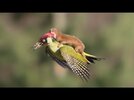There's always a chance that it's an unusual visitor blown in from somewhere.
Here are three bird types that might fit some of the general criteria that are actually expected in the UK.
Sandpipers & other wading birds.
Rails, crakes & coots.
Lapwings & plovers.
If nothing on there comes close, try wading through the full
A to Z.
I'm wondering whether it might be a pheasant. Whilst many will instantly recognise a
typical cock pheasant, there are loads of different ornamental variations running around our countryside these days.
Melanistic birds ranging from green to almost black are increasingly common. Dark cock birds don't always have the obvious red wattling on their heads.

